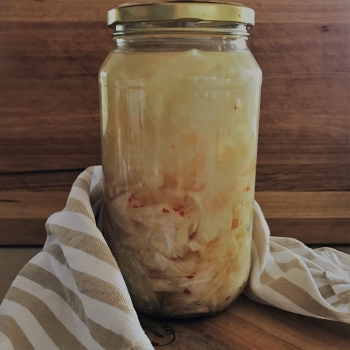By: Judy Davie - The Food Coach
 The other day I bought a huge celeriac which was far bigger than I needed. Celeriac will store whole for a few months in the crisper section of the fridge however, given that I'd already cut into it and exposed it to air, I was keen to use it quickly and try to recreate an amazing fermented celeriac we'd enjoyed at a fancy French restaurant the year before. The other day I bought a huge celeriac which was far bigger than I needed. Celeriac will store whole for a few months in the crisper section of the fridge however, given that I'd already cut into it and exposed it to air, I was keen to use it quickly and try to recreate an amazing fermented celeriac we'd enjoyed at a fancy French restaurant the year before.
Fermented foods have been on trend for many years and with the food industry recognising there is money to be had, there are commercial fermented foods to buy in every guise. Making your own is easy, cheaper and possibly (but not guaranteed to be) healthier than a bought product. Whether any of them, commercial or home-made are as healthy as they are purported to be is difficult to prove.
The main health message is that fermented foods are probiotics and support a healthy gutbiome. The human body is inhabited by trillions of bacteria, viruses, parasites, and fungi and the largest and most complex microbiome is the gastrointestinal tract, which is estimated to contain as many as 1,000 microbial cells in every gram of stool. When the healthy gut microbiome is disrupted we are prone to ill-health. Today illnesses such as IBS, chronic fatigue, fibromyalgia, depression, and even diabetes and obesity are suspected to stem from or, at least be contributed to, an imbalanced gutbiome.
Our ancestors have been fermenting foods for years. The anaerobic process, which means it happens without oxygen, uses bacteria or yeasts to convert sugars from food to other compounds like alcohol or organic acids, while also producing energy for themselves. The end product is either alcohol or lactic acid. Our ancestors made mead from fermented honey and water, wine and beer for the same reasons that we drink alcohol today, and they fermented fruits and vegetables with sugar or salt primarily as a means to preserve it. That celeriac bulb may last in a cool space for 3 months but after that unless preserved, it will perish and be inedible. Back in the days of food insecurity without refrigeration and a plentiful food supply, they had to find ways to preserve food for months beyond its typical shelf life.
The fermentation process changes the structure of food, creates a lactic acid by-product which helps digestion and makes the nutrients in the food more bio-available. It also makes the food very flavoursome and delicious but we can't know for sure whether it contains live probiotics.
I discussed whether the health benefits in fermented foods are all they're cracked up to be with nutritionist and health scientist Dr Joanna McMillan whose recent work on gut microbiome delved into this subject and the bottom line according to her is…
it's really hard to tell:-
1. How many live microorganisms are contained in a commercial or home-made product.
2. Whether any live microorganisms have survived the rigid sterilisation process required to take a commercial food product to market.
3. If the product does contain live microorganisms, how many will survive the journey through the highly acidic digestive tract.
Which brings me back to where I started with this article. Certainly you should have a go at making fermented vegetables because they taste great and it saves on food waste. You will also save money because they are pretty expensive to buy, and if you have problems with digestion they can help with that too.
Will they act as probiotics?
Who knows but they will help feed the bacteria that's already in your gut and that's certainly a good thing.
A final note on salt
Fermented vegetables should be treated as a condiment and not eaten in the same volume as you would eat fresh vegetables. The fermentation process typically uses large amounts of salt which should be taken in moderation to prevent high blood pressure and strokes.
Fermented Celeriac
1 large mouthed jar with lid
1 celeriac bulb
½ tsp smoked chilli flakes
1 tbs sea salt
2 cups filtered water
Wash and rinse the jar thoroughly - also wash your hands!
Peel the celeriac and using a mandolin or vegetable peeler, cut thin strips of celeriac into a bowl.
Use your hands to rub the salt through the celeriac to prevent it from discolouring.
Transfer the celeriac to the jar and top with water. Make sure the celeriac is completely submerged.
Place the jar on a plate and allow to ferment at room temperature for about 6 day or longer.
You should see bubbles forming on the surface of the ferment.
Once you are happy with the flavour, store the jar in the fridge.
Enjoy chilled.
Comments
|